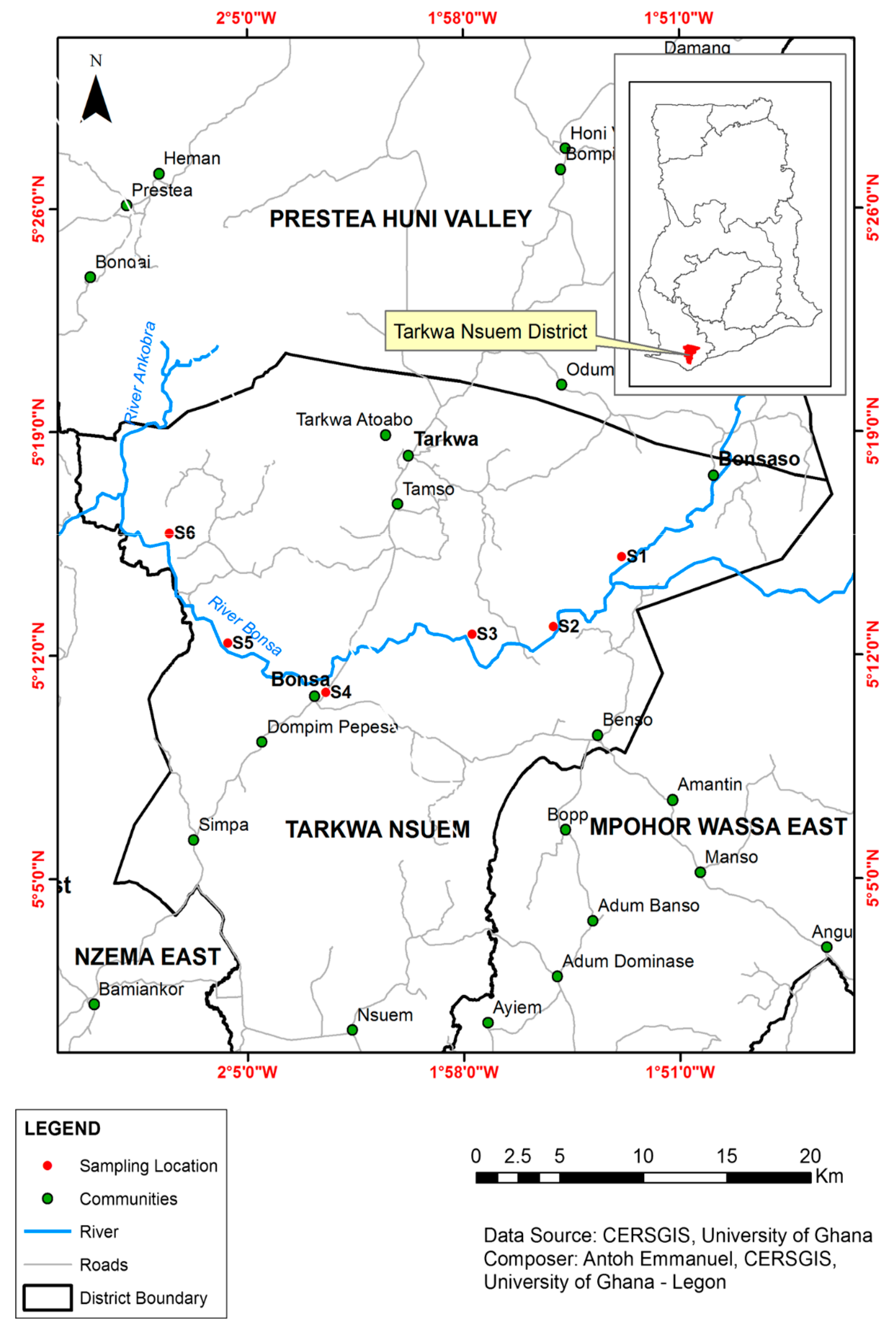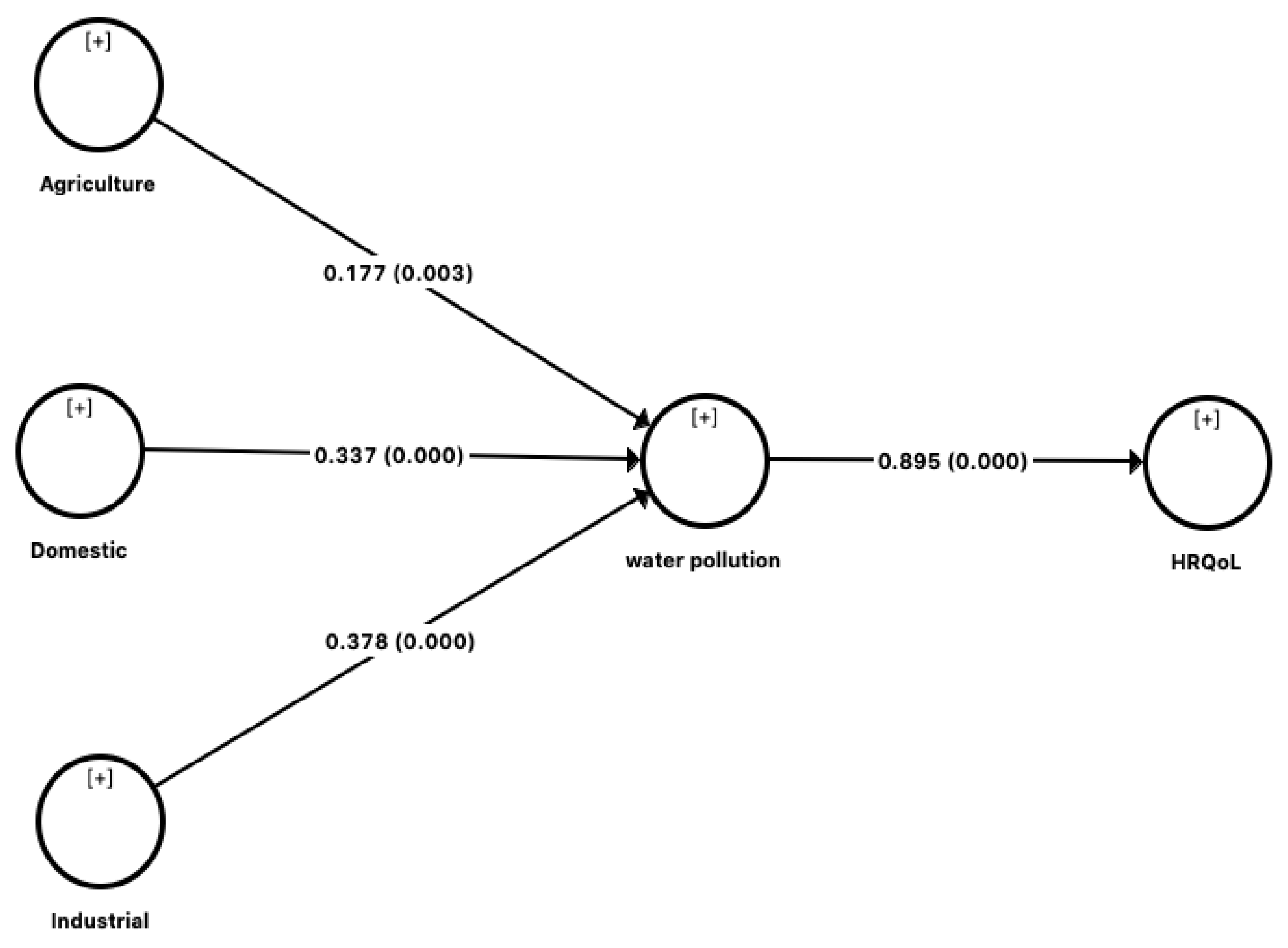The Impact of Human Activities on River Pollution and Health-Related Quality of Life: Evidence from Ghana
Abstract
1. Introduction
2. Method
2.1. Study Setting
2.2. Materials and Methods
2.3. Analytical Methods
3. Results
3.1. Demographic Characteristics of the Respondent
3.2. Analysis of Measurement Models
3.3. Evaluation of Structural Model
4. Discussion
5. Conclusions
Supplementary Materials
Author Contributions
Funding
Institutional Review Board Statement
Informed Consent Statement
Data Availability Statement
Acknowledgments
Conflicts of Interest
References
- Massawe, P.I.; Mvena, A.; Nyoki, D.; Chambile, E.L. Effects of Anthropogenic Activities on Availability of Clean and Safe Water: A Case of Uluguru Forest Catchment Areas of Morogoro, Tanzania. South Asian J. Dev. Res. 2019, 1, 114–123. [Google Scholar]
- Emmanuel, A.Y.; Jerry, C.S.; Dzigbodi, D.A. Review of environmental and health impacts of mining in Ghana. J. Health Pollut. 2018, 8, 43–52. [Google Scholar] [CrossRef]
- Jaywant, S.A.; Arif, K.M. A comprehensive review of microfluidic water quality monitoring sensors. Sensors 2019, 19, 4781. [Google Scholar] [CrossRef]
- Obiri-Yeboah, A.A.; Amoah, A.S.; Gbeckor-Kove, M.S. Analysis of congestion on Some Road Link Sections Using Roadside Friction In Congestion Index in Kumasi. Int. J. Traffic Transp. Eng. 2020, 10, 31–40. [Google Scholar]
- Riou, M.; Carvalho Diniz, E. Bottom up urbanism: Exploring the potential of bottom up initiatives as to encourage pro-environmental behaviour change and action. Psychology 2017. Available online: https://www.semanticscholar.org/paper/Bottom-up-urbanism-%3A-Exploring-the-potential-of-up-Riou-Diniz/2441ac699e071012796d63f485f1bf7386a1b674#paper-header (accessed on 18 August 2022).
- Száraz, L. Pro-environmental characteristics of urban co-housing communities. Geogr. Locality Stud. 2015, 3, 490–529. [Google Scholar]
- Obiri-Yeboah, A.; Nyantakyi, E.K.; Mohammed, A.R.; Yeboah, S.I.I.K.; Domfeh, M.K.; Abokyi, E. Assessing potential health effect of lead and mercury and the impact of illegal mining activities in the Bonsa river, Tarkwa Nsuaem, Ghana. Sci. Afr. 2021, 13, e00876. [Google Scholar] [CrossRef]
- Affum, A.O.; Dede, S.O.; Nyarko, B.J.B.; Acquaah, S.O.; Kwaansa-Ansah, E.E.; Darko, G.; Dickson, A.; Affum, E.A.; Fianko, J.R. Influence of small-scale gold mining and toxic element concentrations in Bonsa river, Ghana: A potential risk to water quality and public health. Environ. Earth Sci. 2016, 75, 178. [Google Scholar] [CrossRef]
- Quesada, H.B.; Baptista, A.T.A.; Cusioli, L.F.; Seibert, D.; de Oliveira Bezerra, C.; Bergamasco, R. Surface water pollution by pharmaceuticals and an alternative of removal by low-cost adsorbents: A review. Chemosphere 2019, 222, 766–780. [Google Scholar] [CrossRef]
- Hair, J.; Hollingsworth, C.L.; Randolph, A.B.; Chong, A.Y.L. An updated and expanded assessment of PLS-SEM in information systems research. Ind. Manag. Data Syst. 2017, 117, 442–458. [Google Scholar] [CrossRef]
- Henseler, J. Partial least squares path modeling: Quo vadis? Qual. Quant. 2018, 52, 1–8. [Google Scholar] [CrossRef]
- Larabi, I.A.; Fabresse, N.; Etting, I.; Nadour, L.; Pfau, G.; Raphalen, J.H.; Philippe, P.; Edel, Y.; Alvarez, J.C. Prevalence of New Psychoactive Substances (NPS) and conventional drugs of abuse (DOA) in high risk populations from Paris (France) and its suburbs: A cross sectional study by hair testing (2012–2017). Drug Alcohol Depend. 2019, 204, 107508. [Google Scholar] [CrossRef] [PubMed]
- Hair, J.F., Jr.; Sarstedt, M.; Ringle, C.M.; Gudergan, S.P. Advanced Issues in Partial Least Squares Structural Equation Modeling; saGe Publications: Thousand Oaks, CA, USA, 2017. [Google Scholar]
- Boadi, E.B.; Wenxin, W.; Bentum-Micah, G.; Asare, I.K.J.; Bosompem, L.S. Impact of service quality on customer satisfaction in Ghana hospitals: A PLS-SEM approach. Can. J. Appl. Sci. Technol. 2019, 7. Available online: http://www.onlinejournal.org.uk/index.php/cajast/article/view/537 (accessed on 18 August 2022).
- Henseler, J.; Ringle, C.M.; Sarstedt, M. A new criterion for assessing discriminant validity in variance-based structural equation modeling. J. Acad. Mark. Sci. 2015, 43, 115–135. [Google Scholar] [CrossRef]
- Ashley, E.A.; Dhorda, M.; Fairhurst, R.M.; Amaratunga, C.; Lim, P.; Suon, S.; Sreng, S.; Anderson, J.M.; Mao, S.; Sam, B.; et al. Spread of artemisinin resistance in Plasmodium falciparum malaria. N. Engl. J. Med. 2014, 371, 411–423. [Google Scholar] [CrossRef] [PubMed]
- Pires, A.P.F.; Srivastava, D.S.; Marino, N.A.C.; Macdonald, A.A.M.; Figueiredo-Barros, M.P.; Farjalla, V.F. Interactive effects of climate change and biodiversity loss on ecosystem functioning. Ecology 2018, 99, 1203–1213. [Google Scholar] [CrossRef] [PubMed]
- Oberholster, P.; Botha, A.-M.; Hill, L.; Strydom, W. River catchment responses to anthropogenic acidification in relationship with sewage effluent: An ecotoxicology screening application. Chemosphere 2017, 189, 407–417. [Google Scholar] [CrossRef] [PubMed]
- Wimalawansa, S.A.; Wimalawansa, S.J. Impact of changing agricultural practices on human health: Chronic kidney disease of multi-factorial origin in Sri Lanka. Wudpecker J. Agric. Res. 2014, 3, 110–124. [Google Scholar]
- Halder, J.N.; Islam, M.N. Water pollution and its impact on the human health. J. Environ. Hum. 2015, 2, 36–46. [Google Scholar] [CrossRef]
- Boelee, E.; Geerling, G.; van der Zaan, B.; Blauw, A.; Vethaak, A.D. Water and health: From environmental pressures to integrated responses. Acta Trop. 2019, 193, 217–226. [Google Scholar] [CrossRef] [PubMed]
- Schwarzenbach, R.P.; Egli, T.; Hofstetter, T.B.; Von Gunten, U.V.; Wehrli, B. Global water pollution and human health. Annu. Rev. Environ. Resour. 2010, 35, 109–136. [Google Scholar] [CrossRef]
- Truter, J.C.; van Wyk, J.H.; Oberholster, P.J.; Botha, A.-M.; Mokwena, L.M. An evaluation of the endocrine disruptive potential of crude oil water accommodated fractions and crude oil contaminated surface water to freshwater organisms using in vitro and in vivo approaches. Environ. Toxicol. Chem. 2017, 36, 1330–1342. [Google Scholar] [CrossRef] [PubMed]
- Afroz, R.; Masud, M.M.; Akhtar, R.; Duasa, J.B. Water pollution: Challenges and future direction for water resource management policies in Malaysia. Environ. Urban. ASIA 2014, 5, 63–81. [Google Scholar] [CrossRef]
- Keiser, D.A.; Shapiro, J.S. Consequences of the Clean Water Act and the demand for water quality. Q. J. Econ. 2019, 134, 349–396. [Google Scholar] [CrossRef]
- Jawad, L.A. The Effects of Thermal Pollution on the Aquatic Life in the Southern Marshes of Iraq, in Southern Iraq’s Marshes; Springer: Berlin/Heidelberg, Germany, 2021; pp. 559–571. [Google Scholar]
- Rouillard, J.; Lago, M.; Abhold, K.; Röschel, L.; Kafyeke, T.; Mattheiß, V.; Klimmek, H. Protecting aquatic biodiversity in Europe: How much do EU environmental policies support ecosystem-based management? Ambio 2018, 47, 15–24. [Google Scholar] [CrossRef]
- Kinnunen, P.; Obenaus-Emler, R.; Raatikainen, J.; Guignot, S.; Guimerà, J.; Ciroth, A.; Heiskanen, K. Review of closed water loops with ore sorting and tailings valorisation for a more sustainable mining industry. J. Clean. Prod. 2021, 278, 123237. [Google Scholar] [CrossRef]
- George, M.O.; Ephrahim, S.S.; Onyeka, I.N. Impacts of mining on water resources in South Africa: A review. Sci. Res. Essays 2010, 5, 3351–3357. [Google Scholar]
- Jhariya, D.C.; Khan, R.; Thakur, G.S. Impact of mining activity on water resource: An overview study. In Proceedings of the Recent Practices and Innovations in Mining Industry, Raipur, India, 6 September 2016; pp. 19–20. [Google Scholar]
- Azanu, D.; Styrishave, B.; Darko, G.; Weisser, J.J.; Abaidoo, R.C. Occurrence and risk assessment of antibiotics in water and lettuce in Ghana. Sci. Total Environ. 2018, 622, 293–305. [Google Scholar] [CrossRef]
- Rüdel, H.; Diaz Muñiz, C.; Garelick, H.; Kandile, N.G.; Miller, B.W.; Pantoja Munoz, L.; Peijnenburg, W.J.; Purchase, D.; Shevah, Y.; Van Sprang, P.; et al. Consideration of the bioavailability of metal/metalloid species in freshwaters: Experiences regarding the implementation of biotic ligand model-based approaches in risk assessment frameworks. Environ. Sci. Pollut. Res. 2015, 22, 7405–7421. [Google Scholar] [CrossRef]
- Kaufman, D.G.; Franz, C.M. Biosphere 2000: Protecting our Global Environment, Kendall; Hunt Publishing: Dubuque, Iowa, 1996. [Google Scholar]



| Latent Variables | Convergent Validity | Internal Consistency Reliability | |
|---|---|---|---|
| The Average Variance Extracted (AVE) | Composite Reliability | Cronbach’s Alpha | |
| >0.50 | >0.70 | >0.70 | |
| Agriculture | 0.631 | 0.895 | 0.854 |
| Domestic | 0.578 | 0.872 | 0.816 |
| HRQoL | 0.855 | 0.946 | 0.912 |
| Industrial | 0.596 | 0.879 | 0.827 |
| Water pollution | 0.645 | 0.845 | 0.725 |
| Agriculture | Domestic | HRQoL | Industrial | Water Pollution | |
|---|---|---|---|---|---|
| Agriculture | 0.795 | ||||
| Domestic | 0.853 | 0.760 | |||
| HRQoL | 0.828 | 0.896 | 0.824 | ||
| Industrial | 0.861 | 0.855 | 0.893 | 0.772 | |
| water pollution | 0.790 | 0.811 | 0.895 | 0.818 | 0.803 |
| f2 | VIF | |
|---|---|---|
| Water pollution -> HRQoL | 4.029 | 1.000 |
| Agricultural activities -> Water pollution | 0.023 | 4.828 |
| Domestic activities -> Water pollution | 0.088 | 4.626 |
| Industrial activities -> Water pollution | 0.105 | 4.875 |
| Path Coefficients | Original Sample (O) | T Statistics (|O/STDEV|) | p Values | Decision |
|---|---|---|---|---|
| Water pollution -> HRQoL | 0.895 | 85.361 | 0.000 | Yes |
| Agricultural activities -> Water pollution | 0.177 | 3.000 | 0.003 | Yes |
| Domestic activities -> Water pollution | 0.337 | 6.143 | 0.000 | Yes |
| Industrial activities -> Water pollution | 0.378 | 6.332 | 0.000 | Yes |
Publisher’s Note: MDPI stays neutral with regard to jurisdictional claims in published maps and institutional affiliations. |
© 2022 by the authors. Licensee MDPI, Basel, Switzerland. This article is an open access article distributed under the terms and conditions of the Creative Commons Attribution (CC BY) license (https://creativecommons.org/licenses/by/4.0/).
Share and Cite
Zhou, L.; Appiah, R.; Boadi, E.B.; Ayamba, E.C.; Larnyo, E.; Antwi, H.A. The Impact of Human Activities on River Pollution and Health-Related Quality of Life: Evidence from Ghana. Sustainability 2022, 14, 13120. https://doi.org/10.3390/su142013120
Zhou L, Appiah R, Boadi EB, Ayamba EC, Larnyo E, Antwi HA. The Impact of Human Activities on River Pollution and Health-Related Quality of Life: Evidence from Ghana. Sustainability. 2022; 14(20):13120. https://doi.org/10.3390/su142013120
Chicago/Turabian StyleZhou, Lulin, Ruth Appiah, Emmanuel Bosompem Boadi, Emmanuel Ceasar Ayamba, Ebenezer Larnyo, and Henry Asante Antwi. 2022. "The Impact of Human Activities on River Pollution and Health-Related Quality of Life: Evidence from Ghana" Sustainability 14, no. 20: 13120. https://doi.org/10.3390/su142013120
APA StyleZhou, L., Appiah, R., Boadi, E. B., Ayamba, E. C., Larnyo, E., & Antwi, H. A. (2022). The Impact of Human Activities on River Pollution and Health-Related Quality of Life: Evidence from Ghana. Sustainability, 14(20), 13120. https://doi.org/10.3390/su142013120





